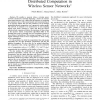79 search results - page 7 / 16 » RIPPLE Authentication for Network Coding |
PKC
2009
Springer
14 years 9 months ago
2009
Springer
Network coding offers increased throughput and improved robustness to random faults in completely decentralized networks. In contrast to traditional routing schemes, however, netw...
INFOCOM
2005
IEEE
14 years 2 months ago
2005
IEEE
— We consider a scenario where a wireless sensor network is formed by randomly deploying n sensors to measure some spatial function over a field, with the objective of computing...
ESORICS
2007
Springer
14 years 3 months ago
2007
Springer
Port knocking is a technique first introduced in the blackhat and trade literature to prevent attackers from discovering and exploiting potentially vulnerable services on a networ...
INFOCOM
2002
IEEE
14 years 1 months ago
2002
IEEE
—Enhanced network services often involve allocating resources (bandwidth/buffer space) preferentially to packets belonging to certain flows or traffic classes. Such services ar...
MOBICOM
1996
ACM
14 years 1 months ago
1996
ACM
Even as mobile computing and network computing are gaining momentum, Internet security is sharing the spotlight. Security and authentication on open networks is already a difficul...

